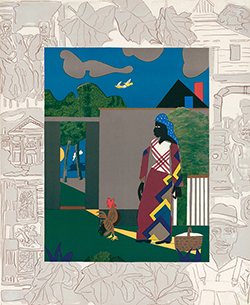| Pepper Jelly Lady
= 1980,
Color Lithograph.
Gelburd/Rosenberg
#56. Edition 150. Signed and annotated Artist's Proof in pencil, lower right.
Image size/sheet size 25 7/8 x 21 3/16 inches (657 x 538 mm).
A superb, richly-inked impression, with fresh, vivid colors, on Arches, heavy, cream wove paper; the image extending to the sheet edges, in excellent condition. A rare proof impression with unique hues in the grays and yellow.
Based on one of Bearden’s boldly colored cubist collages, “Pepper Jelly Lady” shows a West Indian woman selling homemade jelly in front of a walled estate. It was originally part of a portfolio of six prints by Bearden, Ansel Adams, Audrey Flack, Sam Francis, Robert Indiana, and Wayne Thiebaud that were created by the artists to be sold by the Democratic Committee Service Corporation to raise funds for Jimmy Carter’s 1980 presidential campaign. This particular lithograph exemplifies the Louis Armstrong-like optimism of Bearden’s work, in which the black experience in America is portrayed honestly but hopefully. “Even though you go through these terrible experiences, you come out feeling good,” he once said. “That’s what the blues say and that’s what I believe—life will prevail. That’s why I’ve gone back to the South and to jazz."
‘In this work, Bearden returns to his memories of the South and Mecklenburg County.’
—High Museum of Art
Literature: A Century of African American Art: The Paul R. Jones Collection, Amalia K. Amaki, Rutgers University Press, 2004. The Paul R. Jones collection is one of the oldest, largest, and most comprehensive holdings of African American art in the world.
Collections: Albright-Know Art Gallery, Carleton College Art Collection, High Museum of Art, Hirshhorn Museum, Library of Congress, Smart Museum of Art, Smart Musuem of Art's Collection, Smithsonian American Art Museum, University of Alabama Paul R. Jones Museum.
$8000. |
 |


